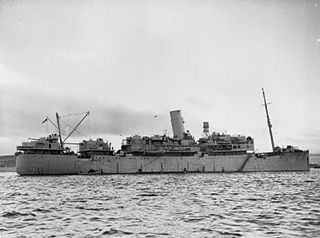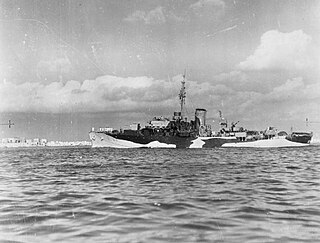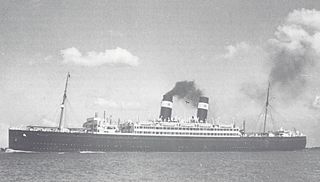Related Research Articles

HMS Cheshire was a passenger ship that was built in Scotland in 1927 and scrapped in Wales in 1957. She belonged to Bibby Line, which ran passenger and cargo services between Rangoon in Burma and various ports in Great Britain, via the Suez Canal and Gibraltar. The Admiralty requisitioned her in 1939 and had her converted into an armed merchant cruiser (AMC). She was converted into a troopship in 1943, and returned to civilian service in 1948.

SS Ceramic was an ocean liner built in Belfast for White Star Line in 1912–13 and operated on the Liverpool – Australia route. Ceramic was the largest ship serving the route until P&O introduced RMS Mooltan in 1923.

Empire Battleaxe was a British ship of the Second World War and as HMS Donovan in service with the Royal Navy just after the Second World War. Built as a Type C1-S-AY1 Landing Ship, Infantry named Cape Berkeley she then saw merchant service as Empire Battleaxe before being commissioned into the Royal Navy as HMS Empire Battleaxe and then Donovan. After she was decommissioned she returned to merchant service as Empire Battleaxe and was returned to the USA where she was renamed Cape Berkeley once again. A proposed sale in 1948 to China and renaming to Hai C fell through and she was scrapped in 1966.

MV Reina del Pacifico was a 17,707 GRT ocean liner of the Pacific Steam Navigation Company. She was built in Northern Ireland in 1930–31 and sailed between Liverpool and the Pacific coast of South America until 1939. She served as a troop ship from 1939 until 1946. She returned to her civilian route in 1948 and was scrapped in 1958.

HMS Bryony was a Flower-class corvette that served in the Royal Navy and Royal Norwegian Navy.

SS Hilary was a British steam passenger liner that was built in 1931 and scrapped in 1959. She spent much of her career on a scheduled service between Liverpool in England and Manaus in Brazil.
Empire Bede was a 6,959 GRT cargo ship which was built by G M Harland & Wolff Ltd, Glasgow in 1942 for the Ministry of War Transport (MoWT). She had a short career, being damaged by a torpedo and then sunk by gunfire on 18 August 1942.
Athelqueen was an 8,202 GRT tanker which was built by Harland & Wolff Ltd, Belfast in 1942 as Empire Benefit for the Ministry of War Transport. Postwar she was sold into merchant service and renamed Athelqueen and later Mariverda, serving until scrapped in 1961.
Empire Chapman was an 8,194 GRT tanker which was built in 1942 by Harland & Wolff, Belfast for the Ministry of War Transport (MoWT). In 1946 she was sold into merchant service and renamed British Commando. She was scrapped in 1959.
Stirlingshire was a 7,067 GRT refrigerated cargo liner that was built in 1944 by Harland & Wolff Ltd, Belfast, United Kingdom as Empire Falkland for the Ministry of War Transport (MoWT. She was sold into merchant service in 1946 and renamed Stirlingshire. She served until 1966, when she was scrapped.

SS Pennland was a transatlantic ocean liner that was launched as Pittsburgh in Ireland in 1920 and renamed Pennland in 1926. She had a succession of UK, German and Dutch owners and operators. In 1940 she was converted into a troopship.

SS Westernland was a transatlantic ocean liner that was launched as Regina in Scotland in 1917, renamed Westernland in 1929 and was scrapped in 1947. She began her career as a troop ship repatriating US troops after the Armistice of 11 November 1918. In the Second World War, Westernland served as a troop ship, repair ship and destroyer depot ship.
RMS Andes was a 26,689 GRT steam turbine Royal Mail Ship, ocean liner, cruise ship, and the flagship of the Royal Mail Lines fleet. She was the second Royal Mail ship to be named after the South American Andes mountain range. The first RMS Andes was an A-class liner launched in 1913. In 1929 that RMS Andes was converted into a cruise ship and renamed Atlantis.

RMS Asturias was a Royal Mail Lines ocean liner that was built in Belfast in 1925. She served in the Second World War as an armed merchant cruiser until she was crippled by a torpedo in 1943. She was out of action until 1948 when she returned to civilian service as an emigrant ship. She became a troop ship in 1954 and was scrapped in 1957.

The SS Runic was a steamship built at Harland and Wolff in Belfast for the White Star Line which entered service in 1901. Runic was the fourth of five Jubilee-class ocean liners built for White Star's Australia service along with her sister ship SS Suevic, where she ran on the Liverpool–Cape Town–Sydney route. She served this route until she was requisitioned for use as a war transport between 1915 and 1919, before returning to the Australia service.

MV Ulster Queen was a passenger ferry operated across the Irish Sea between 1930 and 1940. She became an auxiliary anti-aircraft cruiser, HMS Ulster Queen and never returned to civilian service.

MV Ulster Prince was a passenger ferry operated across the Irish Sea by P&O Ferries between 1967 and 1981. She was sold for further service in the Mediterranean and Far East and was scrapped in 2004.
MV Ulster Prince was a passenger ferry operated across the Irish Sea between 1929 and 1940. She became a total loss in Greece while a troop ship during WWII.

MV Leinster was a passenger ferry operated across the Irish Sea between 1937 and 1966. She was renamed Ulster Prince to replace the 1929 motorship of that name, lost during WWII.

HMS Alisma was a Flower-class corvette that served in the Royal Navy.
References
- 1 2 3 "Ulster Monarch". The Yard/Harland & Wolff. Retrieved 18 August 2018.
- 1 2 "Harland and Wolff Standard Motorships - The Belfast SS Pioneers". Ian Boyle/Simplon Postcards. Retrieved 18 August 2018.
- ↑ "Ulster Monarch". Ship.Rex. Retrieved 18 August 2018.
- 1 2 "HMS Ulster Monarch (F 69)". Uboat.net. Retrieved 18 August 2018.
- ↑ "Ulster Monarch (Belfast SS Co.)". Ship.Rex.com. Retrieved 18 August 2018.